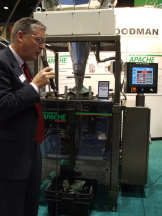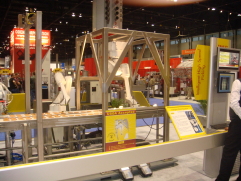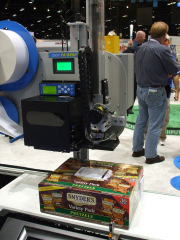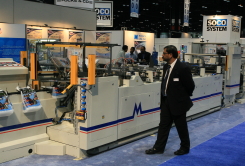OPERATOR-EASY BAG MAKER BOASTS EFFICIENCIES OF 99.9%
NORDSON SYSTEM SAVES GLUE
BIO-POLY BAG WORKS IN MORE WAYS THAN ONE
FIRST USDA-ACCEPTED FOOD PICKING ROBOT DEBUTS
ROHM AND HAAS CAN DO FAST, TOO
NEW DATA STANDARD IS FASTER, SIMPLER
ALL-ELECTRIC LABELER CUTS ENERGY COSTS BY 50%
MAMATA DEMOS ZIPPER WICKETER, HIGHLIGHTS SPEED
ROLL-FED LABELER TOUTS AN ERGONOMIC DESIGN
METAL DETECTOR HAS HIGH SENSITIVITY
ECONOMY PRESSURES COMPANIES TO FOCUS ON EFFICIENCY
BEVERAGE MULTIPACK SYSTEM COVERS ALL THE STEPS
PLATE CLEANER AUTOMATES, IMPROVES PROCESS
WHO WOULD BE OBAMA'S 'PICKENS' FOR A SUSTAINABILITY CZAR?
In the opening monologue of Monday’s Pack Expo keynote presentation, Nestle VP of Sustainability Betsy Cohen boldly predicted “That One” (President-Elect Obama) would name a sustainability czar within his first 12 to 18 months in office.Just seven days into his president-elect term and months ahead of the First Puppy making tracks through the West Wing, historians are already foretelling Obama’s legacy of his eight years as Commander In Chief (yes, save the Second Coming, he will serve for eight years). No doubt that legacy will most certainly, if not deservedly, include full credit for bringing the troops home from Iraq, ferreting out Al Quieda operatives in Afghanistan and, of course, solving the credit crisis. But what legacy--or perhaps more appropriately put--what footprint, will the Obama Administration leave for generations and Administrations that follow?
Is climate change and the impact of manufacturing, to include packaged goods manufacturing, distribution and recovery, important enough to Obama to address early, often and with the courage of his party’s convictions to continue to call itself the “green” party.
Using Cohen’s own analogy of the Wizard of Oz’s tinman, scarecrow and Cowardly Lion for the type of mettle both corporations and a Czar would need exhibit, the question was posed back to Cohen for her recommendations as to whom might possess the heart, brains and courage to lead our Nation’s sustainability efforts.
Somewhat disappointingly, Cohen mentioned Al Gore. Please…great powerpoint slides and an Oscar do not science-based facts make. While Gore has a green footprint the Jolly Green Giant would envy, there are fact-based voids in his arguments the size of the hole in the ozone layer. Sustainability and corporate social responsibility are both science and economic issues--and they are not mutually exclusive.
Second on Cohen’s list was Robert Kennedy Jr. Now we’re getting somewhere. Kennedy already has been named a “Hero of the Planet” by Time.com for his work to restore the Hudson River. I can envision Kennedy with a big green “S” on his superhero cape. His bottled water company, Tear of the Clouds, returns 100% of its profits to the Waterkeeper Alliance Opps, sorry. I’m guessing he might run into some staunch objections from San Francisco residents for even making a bottled water product--eh gads…how could our Sustainability Czar even think about putting water in PET plastic bottles (let’s just forget about the well established global infrastructure for recovering, recycling and even upcycling lightweighted PET).
Kennedy has clout on The Hill, having testified before Congress about the links between global warming and Hurricane Katrina--although no one is certain exactly what his conclusions told us.
He is an ardent supporter of alternative energy, especially wind power. Oh, but wait! He has said he would oppose erecting wind farms on Nantucket Sound where it might obstruct the pristine view from the Kennedy Compound. I wonder if Sarah Palin would mind if her view of Russia from her back porch was obstructed by windmills in the Bering Sea?
On the plus side, Kennedy is a social gadfly, appearing with his white collared shirt-sleeves rolled to the elbows at environmental rallies. And, he’s chatted up David Letterman on his environmental positions. That has to count for something--at least among late-night LOHAS viewers watching on their Energy Star-rated flat panel plasma big screens.
Closer to the packaging industry, Patti Temple Rocks, Dow’s VP of Corporate Reputation garnered a vote from one Pack Expo attendee who cited her gutsy, high-profile PR work in the private sector and her recent leadership role on Dow’s recent Human Elements campaign.
But my vote for Sustainability Czar goes to T. Boone Pickens. Yea, that T. Boone Pickens--the OIL guy. While Kennedy has a resume full of reasons to make him a qualified candidate, and Gore has, well…a great Powerpoint deck and the ability to rub elbows with such noted Hollywood greenies as Leonardo DiCaprio and Branjolena, it’s that whole lack of science thing that gives me pause.
While Pickens has a fully developed national strategy (seewww.solvingenergy.com/pickens/html) he also has a plan boiled down to a grass roots level that real Americans can implement.
What’s most appealing about Pickens is that he already has demonstrated he is willing to spend his own money to support his wildly aggressive plans--and he has plenty of the former to support a long-term commitment to the latter. He and his investment partners have already earmarked $12 billion of private money for the development of wind farms in Texas. Pickens has also established a $4 billion hedge fund, BP Capital, which is invested in natural gas exploration and development.
In all fairness to the other candidates, the down-side to the Pickens’ plan is that he’s an optimist. Math and science both point to the fact that the United States could never achieve a state of oil or energy independence. Whether one believes in the premise of Peak Oil or not, the outputs from even the most efficient wind farms, solar cities, fuel cell automobiles or replacement of oil-driven industries with natural gas simply won’t make up for expected population growth and subsequent energy demands.
Pickens also commands the respect of constituents in both Red- and Blue-leaning states, if for nothing else than his in-your-face discussions of reducing our dependency on foreign oil and, perhaps most importantly, not relying on either the Bush or Obama Administration to do something--or anything.
David Luttenberger, CPP, Director, Packaging Strategies

Kliklok-Woodman
OPERATOR-EASY BAG MAKER BOASTS EFFICIENCIES OF 99.9%
Kliklok-WoodmanBooth #S-1601; 770-981-5200
The Apache low-profile bag maker reaches efficiencies of 99.9% running in a 24/7 cereal plant.
Contributing to this high number is the fact that-through engineering and design, and with non-proprietary controls-the system eliminates operator variability by making set-up and adjustments simple and fast.
The vibration-free frame is center balanced to accommodate a variety of filling systems without the need for additional machinery support. This gives users flexibility in equipment installation. The intermittent-motion bagger hits speeds of 120 packages per minute, with a bag size range from 2 to 12 inches wide by 3 to 25 inches long.
Lisa McTigue Pierce, Editor-in-Chief, Food & Beverage Packaging
NORDSON SYSTEM SAVES GLUE
Nordson Corp.Booth #S-230; 888-667-3766
Nordson has come up with ways for labelers to cut their consumption of hot glue by 50% to 90%.
The company came up with a way to extend its existing system for saving glue in cut-and-stacked label applications. That system, developed last year, involves applying adhesive to a bottle or other container in dots instead of a continuous bloc, and applying a little more adhesive to the label. Nordson claims this innovation can cut adhesive consumption by up to 90%. The latest twist, unveiled at the show, applies a similar principle to roll-fed labels, except that the adhesive is applied only to the label.
Another innovation comes in the form of glue applied to corrugated cases. Instead of depositing lines of adhesive on the substrate, Nordson equipment applies beads or “stitches” (segmented lines). This can give the same box strength with half the glue, the company says.
These adhesive-saving systems can be retrofitted onto most existing labelers, or are available on new equipment from leading labeler manufacturers.
Pan Demetrakakes, Executive Editor, Food & Beverage Packaging
BIO-POLY BAG WORKS IN MORE WAYS THAN ONE
Automated Packaging SystemsBooth #S-1512; 330-573-2300
An additive in these polyethylene EarthAware bags allows them to biodegrade within nine months to five years in landfills, or in commercialandhome composts. The bags shown at Pack Expo are green in color, but can also be clear. The additive doesn’t impact the film’s clarity.
Not only do these bags biodegrade, but they also retain all the same features and benefits of polyethylene because theyarepolyethylene.
The EarthAware line also includes bags made from 100% pre-consumer recycled-content material, tinted green to promote their sustainable message.
Lisa McTigue Pierce, Editor-in-Chief, Food & Beverage Packaging

FANUC Robotics
FIRST USDA-ACCEPTED FOOD PICKING ROBOT DEBUTS
FANUC RoboticsBooth #N-4336; 248-377-7000
FANUC Robotics debuted its M-430iA food-picking robot, the first and only robot that meets meat and poultry processing hygiene requirements. Using visual line tracking, the machine is capable of picking primary and packaged products at speeds up to 120 cycles per minute continuously. It also won the “2007 Robot of the Year” award in Japan.
Randy Hofbauer, Associate Editor, Food & Beverage Packaging
ROHM AND HAAS CAN DO FAST, TOO
Rohm and HaasBooth #E-8715; 215-592-3000
Across the show floor, exhibitors emphasize the speed of their presses, bag makers, palletizers or extruders. Rarely does an adhesive company boast about speed, but Mor-Free 75-164 from Rohm and Haas gives the Philadelphia, Pa.-based manufacturer plenty of room to talk. A new solventless laminating adhesive with a significantly shortened process time, Mor-Free 75-164 can cure to slit within four to six hours of application, be converted into a pouch within 24 hours and be fully chemically cured and ready to accept product within three days, says John Norder Jr., business manager with Rohm and Haas. The adhesive is hardy, too, as it features a high level of heat and chemical resistance, perfect for hot fill applications, such as boiling water.
Sayre Kos, Associate Editor, Flexible Packaging
NEW DATA STANDARD IS FASTER, SIMPLER
Sercos North AmericaBooth #C-17; 850-269-0908
SERCOS III, a communications standard for machine control that uses Ethernet, was unveiled Tuesday at a Pack Expo press conference.
SERCOS, the association of suppliers and users that manages the SERCOS standard, decided last year to make the next version of SERCOS run over Ethernet, which is becoming the most popular industrial communications protocol. The result is SERCOS III, a standard which has the potential for faster data transfer with simpler wiring.
SERCOS III has a capacity of 100 megabits per second (up from 16 for SERCOS II) and a cycle time of 31.5 microseconds (twice as fast as SERCOS II). It can send data in both directions across a ring network, for redundancy, and can immediately switch to line-topographic data transmission in case of a break in a ring network.
Practically speaking, this means that data for motor drives, input/output ports and safety parameters such as motor speed limits can all travel over the same bus, or set of wires and devices. Before, all these functions required separate buses.
SERCOS III is being supported by major manufacturers of servo drives, software, I/O blocks and other control equipment.
Pan Demetrakakes, Executive Editor, Food & Beverage Packaging

Diagraph
ALL-ELECTRIC LABELER CUTS ENERGY COSTS BY 50%
DiagraphBooth #S-1912; 800-722-1125
The Platinum E-Series print-and-apply labeler directly converts electrical power to linear motion control to replace pneumatics. Total energy required is less than 480 watts-or, as marketing guru Bill Myers says, “less energy than a hair dryer."
In this new design, because the low-pressure/high-volume air fan stays on the tamp pad, the system is able to handle many different sizes of labels with no changeover.
Lisa McTigue Pierce, Editor-in-Chief, Food & Beverage Packaging

Mamata USA
MAMATA DEMOS ZIPPER WICKETER, HIGHLIGHTS SPEED
Mamata USABooth #S-2289; 630-801-2320
While Mamata designed its Vega W 800 Plus with easy operation and versatility in mind, it’s hard to ignore the 230 bags per minute that virtually fly from the machine. According to Apurva Kane, senior vice president of Mamata, the zipper wicketer generates bags and pouches 50% faster than its nearest competition, leading to a conversion cost reduction of up to 60%. While demonstrating at Pack Expo, the Vega W 800 is producing simple polyethylene (PE) pouches using flat seals on the edges; an industry first, says Kane.
Sayre Kos, Associate Editor, Flexible Packaging
ROLL-FED LABELER TOUTS AN ERGONOMIC DESIGN
KHS USA Inc.Booth #S-812; 262-797-7200
The Innoket 360 roll-fed labeler incorporates an ergonomic and hygienic design. All of the machine parts are accessible for operations. And changeover and maintenance times are reduced with this machine, the company says. The glue tank and the gluing roller were design for energy efficiency: the gluing roller uses induction heating with sensors in the roller shell. The capacity of the Innoket 360 is 50,000 bottles per hour.
Stefanie Scott, Associate Editor, Beverage Industry

Thermo Fisher Scientific
METAL DETECTOR HAS HIGH SENSITIVITY
Thermo Fisher ScientificBooth #S-1369; 781-622-1000
Thermo Fisher Scientific introduced the newest in its line of APEX metal detectors, the APEX 300. Available in drop-through and pipeline systems, the machinery is small and easy to integrate into a production line. Its multi-coil design gives the highest possible sensitivity, and new signal processing algorithms allow for high-speed scanning and contaminant detection.
Randy Hofbauer, Associate Editor, Food & Beverage Packaging
ECONOMY PRESSURES COMPANIES TO FOCUS ON EFFICIENCY
It’s an age-old adage that the food industry is recession-proof because people have to eat, but with the economy in the doldrums, even some food companies may be taking a second look at large ticket items until they get a clearer forecast on how the New Year will turn out.“There’s a lot of talk about what to expect in 2009,” says Rich Hoskins, president and CEO of Colborne Corp. and Foodbotics Corp., which are based in Lake Forest, Ill. “We’re doing well, but there is some concern by some people about what to expect for 2009, especially when it comes to the big-ticket items.”
Earlier this year, many food companies, especially in the salted snack and baking industries, got hammered by a skyrocketing commodity costs and historically high fuel prices that forced some top executives to take a more careful look at capital expenditures, says Hoskins, whose companies were exhibiting at Pack Expo and Process Expo in Chicago.
The unexpected jump in overhead did not affect smaller purchases of equipment or systems that needed to be replaced, Hoskins stresses. In fact, he notes, food executives are searching for innovative ways to streamline their operations through strategic purchases in the face of rising overhead.
Additionally, many companies are looking to retrofit aging systems to improve throughput, add versatility and minimize changeovers. Not surprisingly, he says, food companies that are fortunate to be in a growth mode continue to make purchases as they did in the past.
“Overall, the push has not necessarily been to add capacity at this time,” Hoskins says. “The push is to add efficiencies.”
With the current credit crunch, the ability to get financing may be putting a temporary damper on some decision-making, adds Hal Miller, vice president of sales at Kwik Lok Corp., Yakima, Wash.
Until October, Miller ranked the demand for equipment and the overall business environment as a “four” out of five, with five being best. While the market for Kwik Lok remains a “four,” mainly because the company deals with bread bag closers and other systems that are more affordable, there has been some noticeable softness in some areas of the industry over the last month. He now ranks the general business environment as a more neutral “three” until there’s more clarity in the market.
According to a recent survey by Clear Seas Research, Troy, Mich., the headline-grabbing, stock-slumping credit crisis will have a significant impact on food and beverage companies and their operations. In fact, 77% of those surveyed anticipate “moderate” to “great impact” on their company’s businesses.
More than half (56%) of respondents agree that their company’s daily working capital, or cash on hand, will decline as a result of the credit crunch in the U.S. market. Nearly half (48%) note that their company’s ability to make purchases will be adversely impacted by the current state of the economy. However, only 34% indicated that new product development and introductions might decline as a result of the weakening economy.
Surprisingly, only 18% agree with the common belief that the food and beverage industry is recession-proof because “everyone has to eat.” The overwhelming majority (82%) believes the global market may have a direct impact on the industry.
Which parts of the industry will be hurt the most by the current credit crisis? Some 44% of respondents suggest that it’s the foodservice channel, followed by the meat, poultry and seafood industries (17%) and the retail channel (16%). Only 6% say the bakery, snack and candy industries will be most negatively impacted by the current crisis.
The Clear Seas Research CLEAR PULSE survey was conducted in October. For more information, visitwww.clearseasresearch.com.
Dan Malovany, Editor, Snack Food & Wholesale Bakery
BEVERAGE MULTIPACK SYSTEM COVERS ALL THE STEPS
Graphic Packaging International Inc.Booth #S-1244; 888-800-6841
The Quikflex 600G3 multipack system is the company’s third generation packaging system for cans and bottles. The ergonomically designed feeder is positioned waist-high for easy loading. The machine can be custom ordered or retrofitted in the field as needed to run a variety of containers and pack sizes. The system has a capability of 150 packs per minute, or 180 packs per minute if needed during a surge. Quikflex 600G3 has a swing-out tucker wheel and jam detection, as well as non-stick compression belting, which reduces glue build up.
Stefanie Scott, Associate Editor, Beverage Industry
PLATE CLEANER AUTOMATES, IMPROVES PROCESS
OEC Graphics Inc.Booth #E-9743; 920-235-7770
OEC’s latest product, a virtually automatic flexographic plate cleaning system, takes plates-still wet with ink-and flushes, brushes and dries them in just minutes, leaving a printer with clean, refreshed plates ready to store for future use. The system uses a low-odor, neurotoxin-free detergent, not only making the technology an excellent match for printers seeking an efficient, sustainable solution but also a logical choice for companies seeking to protect or extend the life of their printing plates.
Sayre Kos, Associate Editor, Flexible Packaging
